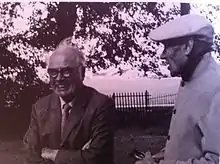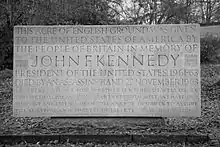Geoffrey Jellicoe
Sir Geoffrey Allan Jellicoe RA VMH (8 October 1900 – 17 July 1996) was an English architect, town planner, landscape architect, garden designer, lecturer and author. His strongest interest was in landscape and garden design.[1][2]
Sir Geoffrey Allan Jellicoe | |
|---|---|
| Born | 8 October 1900 Chelsea, London, England |
| Died | 17 July 1996 (aged 95) |
| Occupation | Architect |
| Projects | JFK Memorial Garden, Runnymede |

Life
Jellicoe was born in Chelsea, London the younger son of Florence Waterson (née Waylett) and her husband, George Edward Jellicoe, publisher's manager, and later publisher.[2] He studied at the Architectural Association in London in 1919 and won a British Prix de Rome for Architecture in 1923, which enabled him to research his first book Italian Gardens of the Renaissance with John C. Shepherd. This pioneering study did much to re-awaken interest in this great period of landscape design and through its copious photographic illustrations publicized the then perilously decayed condition of many of the gardens.
In 1929 he was a founding member of the Landscape Institute and from 1939 to 1949 he was its President. In 1948, he became the founding President of the International Federation of Landscape Architects (IFLA). From 1954 to 1968 he was a member of Royal Fine Art Commission and from 1967 to 1974 a Trustee of Tate Gallery.
Jellicoe taught at the University of Greenwich from 1979 to 1989. He came as a lecturer and visiting critic, usually on six occasions a year.[3]
On 11 July 1936, he married Susan Pares (1907–1986), the daughter of Margaret Ellis (Daisy), née Dixon (1879–1964) and Sir Bernard Pares KBE (1867–1949), the historian and academic known for his work on Russia.[2]
He died in Devon, of heart failure, on the 17 July 1996. He was cremated at Golders Green Crematorium.[2]
National Life Stories conducted an oral history interview (C467/6) with Geoffrey Jellicoe in 1996 for its Architects Lives' collection held by the British Library.[4]
Design projects

Note: All locations below are in England unless stated otherwise.
- 1934–36 Caveman Restaurant, Cheddar Gorge, Somerset
- 1934–39 Ditchley Park, Oxfordshire
- 1935 Plan for Calverton Colliery, Calverton, Nottinghamshire
- 1936 The Great Mablethorpe Plan, Lincolnshire
- 1942 Houses for munitions workers at Whitchurch, Cardiff, Wales[5]
- 1945 "Corbusian" plan for Wolverton (since 1967, part of Milton Keynes)[6]
- 1947 Plan for Hemel Hempstead, Hertfordshire
- 1951–52 East Housing Site, Lansbury Estate, Poplar[7]
- 1952 Church Hill Memorial Garden, Walsall, West Midlands[8]
- 1956 Harvey's Store roof garden, Guildford, Surrey
- 1957–59 Water Gardens, Hemel Hempstead, Hertfordshire
- 1959 Cliveden Rose Garden, Taplow, Buckinghamshire
- 1955–68 Glass Age Development Committee, sponsored by Pilkington Glass with Edward D. Mills and Ove Arup & Partners.[9] Projects included Motopia, the Crystal Span Bridge, plans for Soho, Sea City and others.
- 1964–65 Kennedy Memorial Garden, Runnymede, Surrey[10]
- 1970–90 Shute House, Donhead St Mary, Wiltshire – extensive gardens, his last work, his favourite, and considered to be his finest[11]
- 1972–90 St Paul's Walden Bury, Hertfordshire – garden restoration and additions
- 1979–89 Hartwell House Garden, Buckinghamshire
- 1980–86 Sutton Place Garden, Surrey
- 1984 Moody Gardens, Galveston, Texas, USA
Books and other publications
- Italian Gardens of the Renaissance (with J.C. Shepherd) (1926)
- Baroque Gardens of Austria (1932)
- The Shakespeare Memorial Theatre, Stratford-upon-Avon, etc. (1933)
- Garden Decoration & Ornament for Smaller Houses (1936)
- Gardens of Europe (1937)
- Report accompanying an Outline Plan for Guildford prepared for the Municipal Borough Council (1945)
- Studies in Landscape Design (1960)
- Motopia: A Study in the Evolution of Urban Landscape (1961)[12]
- A Landscape Plan for Sark (1967)
- The Landscape of Man (1975)
- Blue Circle Cement Hope Works Derbyshire (1980?)
- The Guelph Lectures on Landscape Design (1983)
- The Oxford Companion to Gardens (1986)
- The Landscape of Civilisation (1989)
- The Studies of a Landscape Designer over 80 years (c.1993)
- Gardens & Design, Gardens of Europe (1995)
See also
References
- "A Biography of Sir Geoffrey Jellicoe". Nightingale Garden Co. Ltd. 2008. Retrieved 20 March 2013.
- Matthew, H. C. G.; Harrison, B., eds. (23 September 2004), "The Oxford Dictionary of National Biography", The Oxford Dictionary of National Biography, Oxford University Press, pp. ref:odnb/40519, doi:10.1093/ref:odnb/40519, retrieved 6 December 2019
- "Geoffrey Jellicoe and the subconscious". www.gardenvisit.com. Retrieved 5 July 2016.
- National Life Stories, 'Jellicoe, Geoffrey (1 of 5) National Life Stories Collection: Architects' Lives', The British Library Board, 1996. Retrieved 10 April 2018
- The Twentieth Century Society (2017). "1942". 100 Houses 100 Years. London: Batsford. ISBN 978-1-84994-437-3.
- Pevsner, Nikolaus; Williamson, Dr Elizabeth (11 March 1994). Buckinghamshire (Pevsner Architectural Guides). Yale University Press. p. 119.
- http://www.british-history.ac.uk/survey-london/vols43-4/pp223-239#h3-0005
- https://brownhillsbob.com/2009/06/02/the-secret-garden/
- "Obituary: Edward Mills". The Independent. 2 February 1998. Retrieved 22 August 2020.
- "Kennedy Family Coming For Memorial Inauguration". The Times. London (56316): 6. 8 May 1965.
Mr Geoffrey Jellicoe, the architect for the site, said...that the point of the memorial was the landscape rather than any physical monument
- Historic England. "Shute House (Grade II) (1146075)". National Heritage List for England. Retrieved 16 December 2014.
- Jellicoe, Geoffrey (1961). Motopia: A study in the evolution of urban landscape. Studio.
Further reading
- Spens, Michael. The complete landscape designs and gardens of Geoffrey Jellicoe c1994
- Spens, Michael. Gardens of the mind c1992.
External links
- Portrait by Derry Moore, 1992 At the National portrait Gallery – Accessed April 2007
- Portrait by Anne-Katrin Purkiss, 1990 At the National portrait Gallery – Accessed April 2007